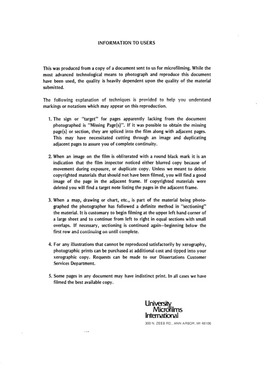| dc.contributor.author | Monney, James Grant, | en_US |
| dc.date.accessioned | 2013-08-16T12:28:24Z | |
| dc.date.available | 2013-08-16T12:28:24Z | |
| dc.date.issued | 1981 | en_US |
| dc.identifier.uri | https://hdl.handle.net/11244/4901 | |
| dc.description.abstract | Although emphases have been placed on the use of models developed on hydraulic network, the use of these models are by no means restricted to this area alone. Both models can quite easily be applied to all other networks meant to transport either fluid or gaseous substances. | en_US |
| dc.description.abstract | The optimization model is applied to a network previously balanced by any acceptable method. Optimal design of the network is achieved, first, by the reduction or decomposition of the entire network to tree-like configurations using a computer algorithm based on graph theory. This done, a modified version of the dynamic programming technique, which does not make use of an objective function and constraints, is applied for the selection of appropriate pipe diameter for each pipe element from a range of up to seven different diameter options for each pipe element. This model is capable of handling the optimal design of extensions to existing network as well as paralleling or replacement of a pipe or a number of pipes. | en_US |
| dc.description.abstract | The development and application of simplified techniques for the analysis and optimal design of distribution network for water supply are discussed in this thesis which is in two parts. The first part deals with an analysis model of a hydraulic network based on the linear graph theory, whereas, the other part describes a graph theoretic approach to network optimization. | en_US |
| dc.description.abstract | In the analysis model, an attempt is made to obtain a network balance without solving directly for the set of non-linear equations which describe the hydraulic behavior of the network. The model, first, computes the propensity drops (analogous to pressure drops) across demand links arising from either known or unknown demands assumed to be concentrated at nodal points of the network. Next, the pressure drops or head losses across the pipe elements (or links) are computed in terms of the drops or losses across the demand links. The flow through the pipe elements are then calculated from the terminal equations of the network. The model is capable of estimating or allocating unknown draw-offs at various nodal points. The application of the model to a hypothetical network is discussed. | en_US |
| dc.format.extent | ix, 257 leaves : | en_US |
| dc.subject | Engineering, Sanitary and Municipal. | en_US |
| dc.title | Graph-theoretic approach to the analysis and optimal design of water distribution network. | en_US |
| dc.type | Thesis | en_US |
| dc.thesis.degree | Ph.D. | en_US |
| dc.thesis.degreeDiscipline | School of Civil Engineering and Environmental Science | en_US |
| dc.note | Source: Dissertation Abstracts International, Volume: 42-07, Section: B, page: 2963. | en_US |
| ou.identifier | (UMI)AAI8129417 | en_US |
| ou.group | College of Engineering::School of Civil Engineering and Environmental Science | |
